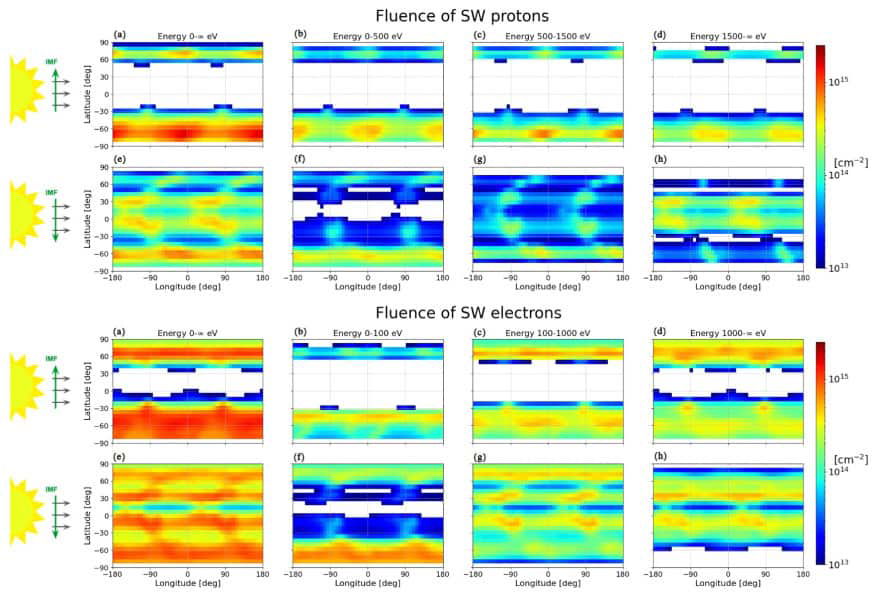A new study has revealed the effects of solar wind plasma precipitation on the surface of Mercury in a mapping effort that offers new insights into the Sun’s impact on the planet and its atmosphere.
The nearest planet to the Sun, Mercury is also our Solar System’s smallest and possesses no geological activity. With little more than a ghost of an atmosphere, the planet’s surface is marked with craters, and despite its modest size, its density is great enough to produce a surface gravity comparable to Mars.
With its weak atmosphere and proportionally feeble intrinsic magnetic field, plasma ejected from the Sun (known as the solar wind) is coupled with Mercury’s surface, resulting in a pattern of “plasma rains” governed by the planet’s magnetic field. Over time, this bombardment by solar plasma precipitation is a main contributor to the alteration of Mercury’s regolith.
Examining these phenomena, a study led by Federico Lavorenti of the Laboratoire Lagrange of the Observatoire de la Côte d’Azur at the Université Côte d’Azur in Nice, France, and the Dipartimento di Fisica “E. Fermi” at the Università di Pisa in Pisa, Italy, now provides a unique geographic perspective on the effects of solar wind plasmas projected onto Mercury.
An expert in producing models of the interactions between the solar wind and magnetic fields, Lavorenti led an international team of scientists that focused on the infall of protons and electrons from solar winds onto Mercury’s surface.


Elizabeth A. Jensen, co-author of a new paper that describes the study and a Senior Scientist with the Planetary Science Institute, says that past studies that have mapped these phenomena typically do so with relation to the time of day rather than according to their geographic location.
“This is one of the first papers to take a close look at how the surface of Mercury is impacted by the solar wind charged particles as a function of location on the surface and the energy of the infalling protons and electrons,” Jensen said in a statement. “This is important for scientists who examine the properties of the surface.”
Jensen says the team’s findings help to shed light on the areas where protons and electrons impact the surface of Mercury and how that contributes to physical effects on the regolith and atmosphere. However, unlike past efforts, the team’s mapping of these phenomena does not rely solely on what time of day this occurs.
Jensen points out that dawn, for instance, dawn occurs at all places across Mercury’s surface. “So you might think that the amount of protons and electrons hitting the surface should be the same all over. However, Mercury has this really strange orbit and rotation property. For every two times Mercury orbits the Sun, it turns on its axis three times.
“We call this a 3-to-2 spin-orbit resonance,” Jensen explained in a statement. “So the Mercury day lasts a little less than a Mercury year.
“Not only that, but Mercury also spends more time with some longitudes facing the Sun than others,” Jensen adds. “Also, the orbit is elliptical, not circular, so the amount of material from the solar wind is different on average depending on where in the orbit it is.”
Jensen and her colleagues say that mapping the infall of particles has to account for these factors, as well as how solar wind plasma precipitation interacts with Mercury’s magnetic field.
Deborah Domingue, also a co-author of the new paper, says the interactions with solar winds occurring on Mercury’s surface help to produce the planet’s tenuous atmosphere, as well as changes to minerals within the regolith on the planet’s surface. However, rather than focusing on these elements, the team’s new study provides useful new data on “the variation in the radiation flux across the surface that is needed for those who do study these phenomena.”
“It’s a complicated system with many moving parts,” Jensen added.
The team’s paper, “Maps of Solar Wind Plasma Precipitation onto Mercury’s Surface: A Geographical Perspective,” appeared in The Planetary Science Journal on September 12, 2023.
Micah Hanks is the Editor-in-Chief and Co-Founder of The Debrief. He can be reached by email at micah@thedebrief.org. Follow his work at micahhanks.com and on Twitter: @MicahHanks.

